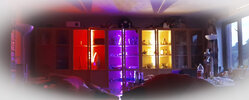In the main I changed to CFL then LED to reduce maintenance, and
@winston1 says, the tungsten bulb had a short life, and will maybe 15 bulbs in the home, one or another was going once a fortnight.
But as to energy saving, I actually wrote to the energy saving trust and asked if they included the inferred heat in the home which means the air temperature can be dropped a couple of degrees in the evening, did the so called energy saving bulb actually save energy when used in doors in a heated room, and they admitted that no survey had ever been carried out, so on average through the year in a central heated room we simple have no idea if the so called energy saving bulb saves any energy, specially if we include manufacturer.
The more to bulbs with a longer life span has caused a problem for me, where I have a draw full of spare bulbs, brand new, but it will likely take longer than my life time to use them all, it did not help when we stocked up on tungsten bulbs before they were withdrawn, then moved to E14 bulbs rather than BA22d so very few places they are still used.
However neither the CFL or the LED produces much inferred heat, when I moved from tungsten to CFL I found I wanted the main living room warmer in the evening than during the day, my central heating was on a time switch, so came on in morning and off when we retired to bed, this needed changing so instead I had a programmable thermostat and the temperature was set 16°C over night, 18°C in the morning, and 20°C in the evening, once this was done returning to tungsten was pointless.
The big change was the kitchen, where we for years had no heating, the problem was more about keeping it cool, so had always been the fluorescent tube, which to get spread of light fixed size, a 65 watt, then a 58 watt tube, however brighter than required so when the LED came out reduced to 22 watt, however also a reduction in the amount of light, then we got an induction hob, so less heat into the room, the oven better insulated, even the kettle boils just one cup of water, so for the first time looked at heating the kitchen.
The difference between our house and father-in-laws house which was next door but one, due to him using gas and us using electric to cook with what huge, he had a very damp kitchen and needed to open the roof light to remove the moisture and out kitchen was much cooler and drier, automatic boil then simmer on the hobs did help.
I think back and wonder how they got away with a house with a gas supply for the cooker, and no cooker hood? No one seemed to worry in late 70's.
But my main point you can't take one product in isolation, one has to consider how it works as a whole, does the tumble drier remove air heated by the central heating or cause a depression in the house and draw in fumes from any fires in the house, be gas coal or wood.
My utility room is not heated, so I can simply put a pipe out of the window for tumble drier, leaving window open so dryer air than in main body of house is drawn in to replace the air used to dry cloths without losing heat from house, however I know next one will likely have a heat pump in it, so not bothering drilling a hole in the wall.
We all tend to relate to what we have, when I lived in an open plan house, I could see no point in TRV on radiators down stairs, but when I went to mothers house with doors between every room, this was completely different. There is no general rule, one has to consider ones own home, and how it works in that home.


